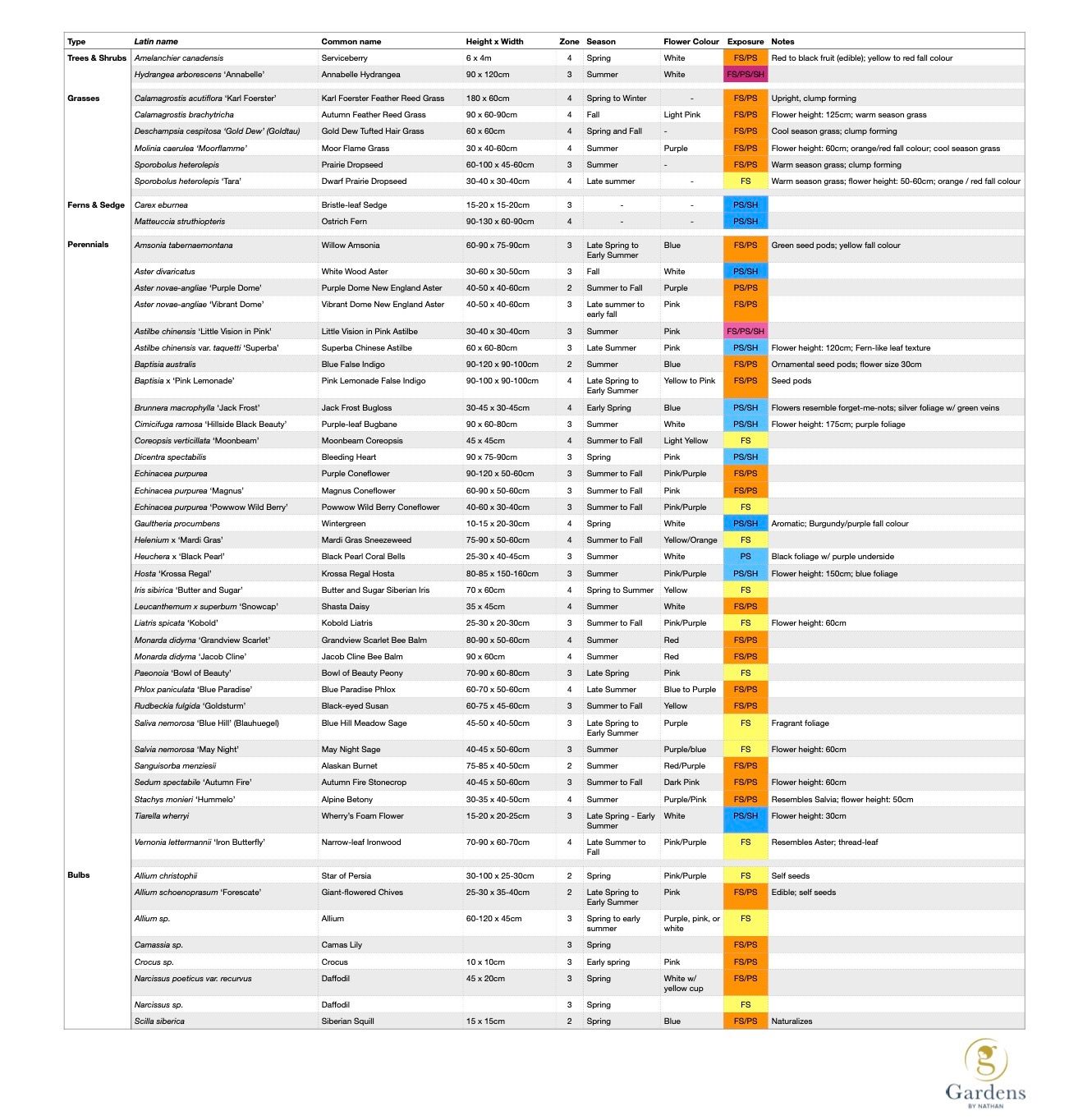Here you will create a wish list of trees, shrubs, perennials, and bulbs that you would like to work with. Don’t worry about being exhaustive with this list, as design is an iterative process. You will undoubtedly change the list as you continue to work through the design. For now, you want to gather more detailed information about the plants you would like to use. The key information that I identify for each plant in my designs are:
- latin name
- common name
- height x width (metric or imperial)
- hardiness zone
- flower season
- flower colour
- sun exposure
- notes (special characteristics)
– ex: fall colour, flower height, fragrance (flower or leaf), soil type
Names
A plant’s latin name is the important one to write down because there is only one for each plant. There can be many common names, depending on where you are and who you are sourcing your material from. Latin names cut out this potential confusion. The only issue you may run into is if the latin name has changed in some way from what you are using as a source. This happens occasionally, but most people will still know the plant by its old latin name.
Sizes
I work in metric, but it doesn’t really matter as long as you are consistent. I often have to do some converting, as both are used interchangeably in Canada. Do whatever causes fewer problems for you.
Hardiness Zone
This information isn’t overly relevant once you start drawing, but is critical to go through at this stage, as it acts as an initial filter for your wish list. You might as well remove any plants that you know won’t grow in your area before you start incorporating your list into a design.
Flowers
Despite there being more to a plant than just its bloom, flower colour and flowering season is a primary consideration when selecting plants. Most resources only provide general information (spring, summer, fall), but some will also provide a month. Just note that the month provided is based on the original source’s location — your milage may vary depending on where you live and your hardiness zone.
The same goes for flower colour. Most resources will list a particular colour — just be aware that things get a little subjective when sources use descriptors other than primary colours.
Sun Exposure
Sun exposure also has some wiggle room in it, due to the sun being a different intensity at different times of the day. Generally speaking, you can think of sun exposure like this:
- full sun
– plant has direct sunlight for the majority of the day - part sun
– plant has direct sunlight for part of the day, and dappled sun (light shade) for the other part of the day - shade
– plant has little (morning) to no direct exposure during the day
Notes
Notes are where I add more detailed information that isn’t always readily available for every plant. For example: fall colour, flower height, fragrance (flower or leaf), and soil type. Add anything you find useful here, or create a new heading if it is something you want to target in each plant used within the design.
Creating a Plant List
Besides the headings listed above, I also break up different types of plants into specific groups: trees; small trees/shrubs; grasses, sedge, ferns (typical matrix plants); perennials; and bulbs. The reason I do this is to help visualize the different plant layers when I go to work on my planting plans. It also saves a fair bit of time if you are working on a larger design (reduces hunting around for names).

Having said that, there is flexibility in how you group your plants. Do what works best for you. At the very minimum, though, try to organize things into three groups: woodies (trees/shrubs); perennials; and bulbs.
Visit a Greenhouse
Once you have your initial plant list completed, and have removed plants that are not hardy to your area, take a trip to a few different greenhouses in your area with your plant list in hand.
This is an opportunity to actually see plants in real life and continue filtering your plant list. You will invariably find new plants that you like better, or discover what you thought looked good online doesn’t quite do the job. This is a crucial step that is often overlooked before work begins on the actual design.
The other reason you should make these trips is simple: find out if your local greenhouses actually carry the plants you want to use, and learn what they cost. Don’t worry about your budget or start limiting your thinking in any way yet. Just gather information to be used later. Take lots of notes and photographs!